中考总练习讲义--冠词和数词
- 格式:doc
- 大小:96.00 KB
- 文档页数:17

冠词和数词1 不定冠词的用法冠词是虚词,本身不能单独使用,也没有词义,它用在名词的前面,帮助指明名词的含义。
英语中的冠词有三种,一种是定冠词(the Definite Article,另一种是不定冠词(the Indefinite Article,还有一种是零冠词(Zero Article。
不定冠词a (an与数词one 同源,是"一个"的意思。
a用于辅音音素前,一般读作[e],而an则用于元音音素前,一般读做[en]。
1 表示"一个",意为one;指某人或某物,意为a certain。
A Mr. Ling is waiting for you.2 代表一类人或物。
A knife is a tool for cutting with.Mr. Smith is an engineer.3 词组或成语。
a little / a few / a lot / a type of / a pile / a great many / many a / as a rule / in a hurry / in a minute / in a word / in a short while / after a while / have a cold / have a try / keep an eye on / all of a sudden2 定冠词的用法定冠词the与指示代词this,that同源,有"那(这个"的意思,但较弱,可以和一个名词连用,来表示某个或某些特定的人或东西。
1特指双方都明白的人或物:Take the medicine.把药吃了。
2上文提到过的人或事:He bought a house.I've been to the house.他买了幢房子。
我去过那幢房子。
3指世上独一物二的事物:the sun,the sky,the moon, the earth4单数名词连用表示一类事物,如:the dollar 美元;the fox 狐狸;或与形容词或分词连用,表示一类人:the rich 富人; the living 生者。
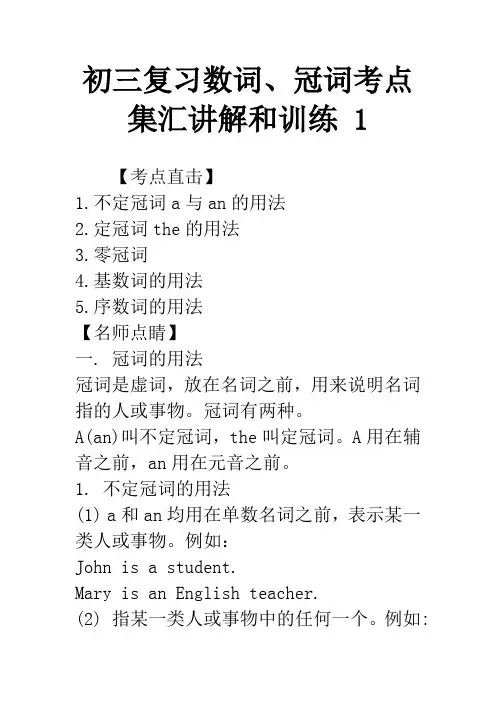
初三复习数词、冠词考点集汇讲解和训练 1【考点直击】1.不定冠词a与an的用法2.定冠词the的用法3.零冠词4.基数词的用法5.序数词的用法【名师点睛】一. 冠词的用法冠词是虚词,放在名词之前,用来说明名词指的人或事物。
冠词有两种。
A(an)叫不定冠词,the叫定冠词。
A用在辅音之前,an用在元音之前。
1. 不定冠词的用法(1) a和an均用在单数名词之前,表示某一类人或事物。
例如:John is a student.Mary is an English teacher.(2) 指某一类人或事物中的任何一个。
例如:A steel worker makes steel.Pass me an apple, please.(3) 指某人或某物,但不具体说明何人或和物。
例如:A student wants to see you.A girl is waiting for you outside.(4) 表示“每一”的意思,相当于every。
例如:Take the medicine three times a day. They go to see their parents once a week.2. 定冠词用法(1) 特指某人或某事物。
例如:The book on the desk is an English dictionary.Beijing is the capital of China.(2) 指说话人和听话人都熟悉的人或事物。
例如:Open the door, please.Jack is in the library.(3) 上文提到过的人或事物。
例如:Yesterday John’s father bought him a new bike. The bike cost him 200 yuan.(4) 表示世界上独一无二的事物。
例如:The sun rises in the east and sets in the west.(5) 用在序数词和形容词最高级之前。
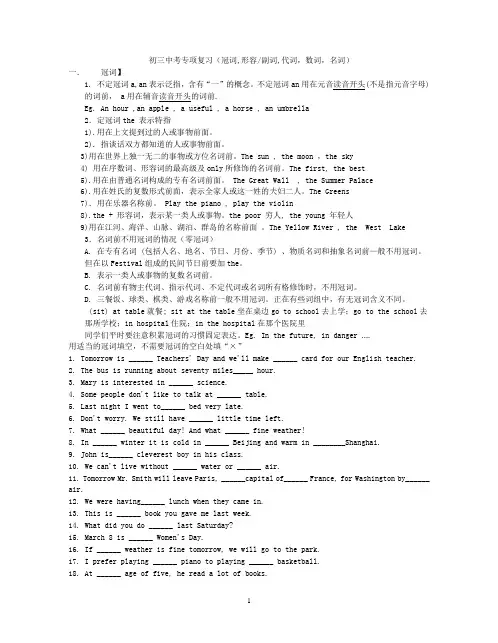
初三中考专项复习(冠词,形容/副词,代词,数词,名词)一.冠词】1. 不定冠词a,an表示泛指,含有“一”的概念。
不定冠词an用在元音读音开头(不是指元音字母)的词前, a用在辅音读音开头的词前.Eg. An hour ,an apple , a useful , a horse , an umbrella2.定冠词the 表示特指1).用在上文提到过的人或事物前面。
2). 指谈话双方都知道的人或事物前面。
3)用在世界上独一无二的事物或方位名词前。
The sun , the moon ,the sky4) 用在序数词、形容词的最高级及only所修饰的名词前。
The first, the best5).用在由普通名词构成的专有名词前面。
The Great Wall , the Summer Palace6).用在姓氏的复数形式前面,表示全家人或这一姓的夫妇二人。
The Greens7).用在乐器名称前。
Play the piano , play the violin8).the + 形容词,表示某一类人或事物。
the poor 穷人, the young 年轻人9)用在江河、海洋、山脉、湖泊、群岛的名称前面。
The Yellow River , the West Lake3.名词前不用冠词的情况(零冠词)A. 在专有名词 (包括人名、地名、节日、月份、季节) 、物质名词和抽象名词前—般不用冠词。
但在以Festival组成的民间节日前要加the。
B. 表示一类人或事物的复数名词前。
C. 名词前有物主代词、指示代词、不定代词或名词所有格修饰时,不用冠词。
D. 三餐饭、球类、棋类、游戏名称前一般不用冠词。
正在有些词组中,有无冠词含义不同。
(sit) at table就餐; sit at the table坐在桌边go to school去上学;go to the school去那所学校;in hospital住院;in the hospital在那个医院里同学们平时要注意积累冠词的习惯固定表达。
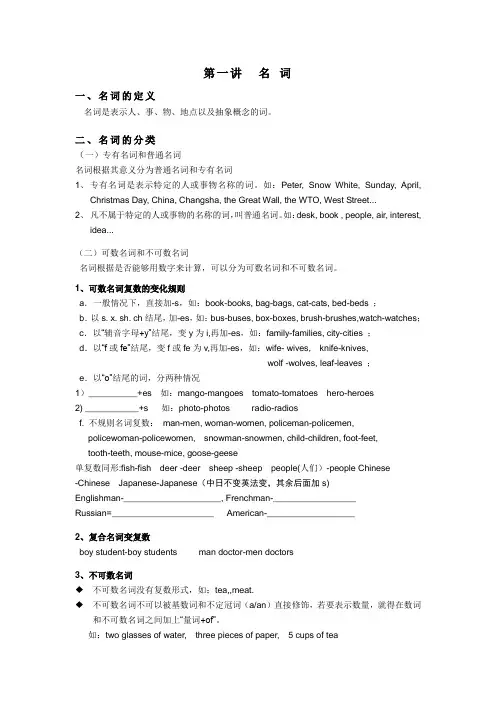
第一讲名词一、名词的定义名词是表示人、事、物、地点以及抽象概念的词。
二、名词的分类(一)专有名词和普通名词名词根据其意义分为普通名词和专有名词1、专有名词是表示特定的人或事物名称的词。
如:Peter, Snow White, Sunday, April,Christmas Day, China, Changsha, the Great Wall, the WTO, West Street...2、凡不属于特定的人或事物的名称的词,叫普通名词。
如:desk, book , people, air, interest,idea...(二)可数名词和不可数名词名词根据是否能够用数字来计算,可以分为可数名词和不可数名词。
1、可数名词复数的变化规则a.一般情况下,直接加-s,如:book-books, bag-bags, cat-cats, bed-beds ;b.以s. x. sh. ch结尾,加-es,如:bus-buses, box-boxes, brush-brushes,watch-watches;c.以“辅音字母+y”结尾,变y为i,再加-es,如:family-families, city-cities ;d.以“f或fe”结尾,变f或fe为v,再加-es,如:wife- wives, knife-knives,wolf -wolves, leaf-leaves ;e.以“o”结尾的词,分两种情况1)__________+es 如:mango-mangoes tomato-tomatoes hero-heroes2) ___________+s 如:photo-photos radio-radiosf. 不规则名词复数:man-men, woman-women, policeman-policemen,policewoman-policewomen, snowman-snowmen, child-children, foot-feet,tooth-teeth, mouse-mice, goose-geese单复数同形:fish-fish deer -deer sheep -sheep people(人们)-people Chinese-Chinese Japanese-Japanese(中日不变英法变,其余后面加s)Englishman-____________________, Frenchman-_________________Russian=_____________________ American-__________________2、复合名词变复数boy student-boy students man doctor-men doctors3、不可数名词◆不可数名词没有复数形式,如:tea,,meat.◆不可数名词不可以被基数词和不定冠词(a/an)直接修饰,若要表示数量,就得在数词和不可数名词之间加上“量词+of”。
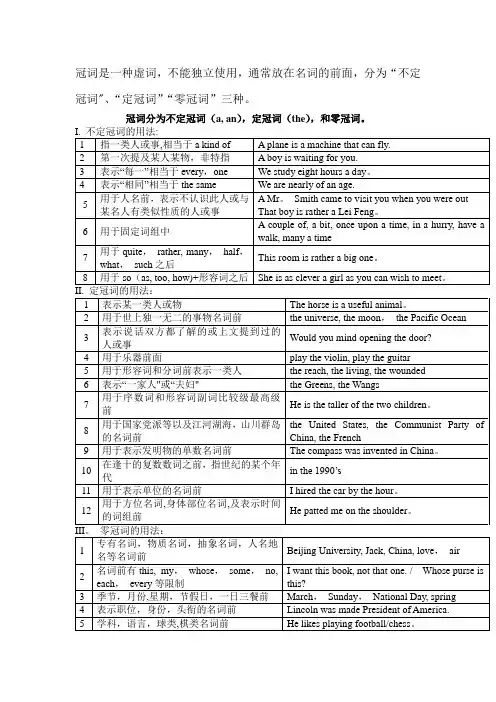
冠词是一种虚词,不能独立使用,通常放在名词的前面,分为“不定冠词"、“定冠词”“零冠词”三种。
冠词分为不定冠词(a, an),定冠词(the),和零冠词。
练一练1、用a或an填空。
___“U"____ice-cream____goalkee—per ____teapot____apple ____office____Englishbook ____um-brella____unit ____hour____honest boy2、根据需要,填写冠词a,an或the。
(1)Who is ____girl behind ____tree?(2) ____old man has two children, ____ son and ____daughter。
(3)This is ____ orange. ____ orange is Lucy’s。
(4)He likes playing ____guitar。
We have ____same hobby。
(5)We all had ____good time last Sunday。
(6)She wants to be____ doctor.实战演练一、基础题1. There is _______ house in the picture。
There is ________old woman near______ house。
A。
an; a; the B. a;an ; the C. the ;a; an D. a; the; an2. He has already worked for ______ hour。
A. theB. anC. aD. 不填3. Alice is fond of playing ______ piano.A。
the B. an C。
a D。
不填4. Beyond ____ stars,the astronaut saw nothing but _____space.A. 不填;the B。

中考考点一、名词一、名词的复数:1.名词变复数的规则形式1).一般情况下直接加s book------books cup-----cups2).以辅音字母+y结尾的,先变y为i再加es .city-------cities family-----families3).以s、x、sh、ch结尾的加es .bus-----buses wish------wishes watch------wathes4).以o结尾的多数加S 初中阶段只有三个单词加es .tomato-----tomatoes potato------potatoes hero-----heroes5).以f、fe 结尾的,先把f、fe变v 再加es .leaf----leaves self---selves shelf----shelves life----lives thief---thieves2.少数名词的复数形式是不规则的。
man----men woman---women child----children foot-----feet tooth----teeth mouse---mice3.单数和复数形式相同。
deer---deer fish----fish sheep----sheep Chinese ----Chinese Japanese---Japanese4.某国人的复数。
1). 中、日不变。
Chinese----Chinese Japanese---Japanese2). 英、法变。
Englishman----Englishmen Frenchman----Frenchmen3). 其余s加后面。
American -----Americans German----Germans Australian---Australians二、不可数名词:1.不可数名词:1).不能直接用数字表数量2).不能直接加a或an 3).没有复数形式4).可用some、any 、lots of、plenty of 、much 修饰5).可用“量词短语”表示2.不可数名词的数量的表示方法: a / 数字+ 量词+ of + 不可数名词a piece of paper a cup of tea a glass of milk三、名词的所有格:1. ’s 所有格。
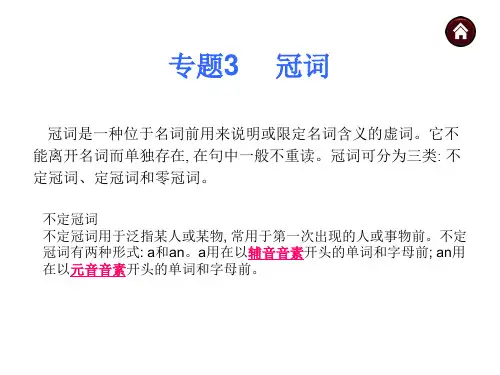
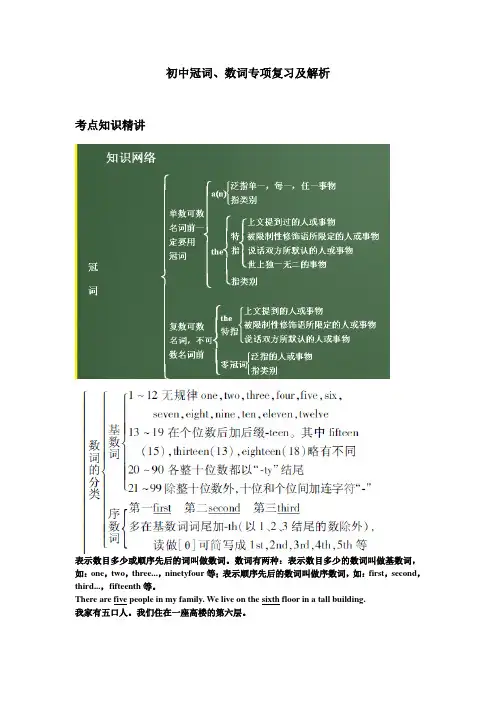
初中冠词、数词专项复习及解析考点知识精讲表示数目多少或顺序先后的词叫做数词。
数词有两种:表示数目多少的数词叫做基数词,如:one,two,three...,ninetyfour等;表示顺序先后的数词叫做序数词,如:first,second,third...,fifteenth等。
There are five people in my family. We live on the sixth floor in a tall building.我家有五口人。
我们住在一座高楼的第六层。
考点一冠词(一)定冠词的用法定冠词the与指示代词this,that同源,有“那(这)个”的意思,但较弱,可以和一个名词连用,来表示某个或某些特定的人或东西。
1.特指双方都明白的人或物。
Take the medicine.把药吃了。
2.上文提到过的人或物。
He bought a house. I've been to the house.他买了幢房子。
我去过那幢房子。
3.指世上独一无二的事物,如:the sun;或用于对两个人或事物比较时起特指作用的比较级前。
He is the taller of the two boys.两个男孩中他较高点。
4.与单数名词连用表示一类事物,如:the dollar“美元”;或与形容词或分词连用表示一类人,如:the rich“富人”;the living“生者”。
5.用在序数词和形容词最高级及形容词only, very, same 等前面。
Where do you live?I live on the second floor.你住在哪?我住在二层。
That's the very thing I've been looking for.那正是我要找的东西。
6.与复数名词连用,指整个群体。
They are the teachers of this school.(指全体教师)他们是这所学校的全体老师。

中考英语语法复习说课稿讲义第三讲:数词、冠词一. 教材分析数词和冠词是中考英语语法的重要内容,本讲主要涉及数词的分类、用法以及冠词的用法。
通过本讲的学习,学生能够掌握数词和冠词的基本概念,了解它们在句子中的作用,并能够正确运用它们。
二. 学情分析学生在之前的学习中已经接触过数词和冠词,对本讲内容有一定的了解。
但部分学生可能对数词的分类和用法掌握不牢固,对冠词的用法也存在一定的困惑。
因此,在教学过程中,需要针对这些学生进行重点讲解和练习。
三. 说教学目标1.知识目标:使学生掌握数词的分类、用法以及冠词的用法。
2.能力目标:培养学生正确运用数词和冠词的能力。
3.情感目标:激发学生学习英语的兴趣,提高学生的自信心。
四. 说教学重难点1.数词的分类和用法。
2.冠词的用法。
五. 说教学方法与手段1.采用情境教学法,通过设定生活场景,让学生在实际语境中学习和运用数词和冠词。
2.使用多媒体教学手段,如PPT、视频等,增加课堂的趣味性,提高学生的学习兴趣。
3.采用任务型教学法,让学生在完成任务的过程中,巩固数词和冠词的用法。
六. 说教学过程1.导入:通过一个简单的数学问题,引出数词的概念,激发学生的学习兴趣。
2.讲解数词:讲解数词的分类和用法,举例说明。
3.讲解冠词:讲解冠词的用法,举例说明。
4.实践练习:设置一些练习题,让学生在实际语境中运用数词和冠词。
5.总结:对本讲内容进行总结,强调数词和冠词的重要性和用法。
6.作业布置:布置一些相关的练习题,巩固所学知识。
七. 说板书设计板书设计要清晰、简洁,能够突出本讲的重点。
主要包括数词的分类、用法和冠词的用法。
八. 说教学评价通过课堂表现、练习题和作业来评价学生的学习效果。
对学生在数词和冠词方面的掌握情况进行全面评估,发现问题,及时进行反馈和讲解。
九. 说教学反思在教学过程中,要不断反思自己的教学方法和手段,根据学生的实际情况进行调整。
同时,要关注学生的学习进度,确保每个学生都能掌握数词和冠词的用法。
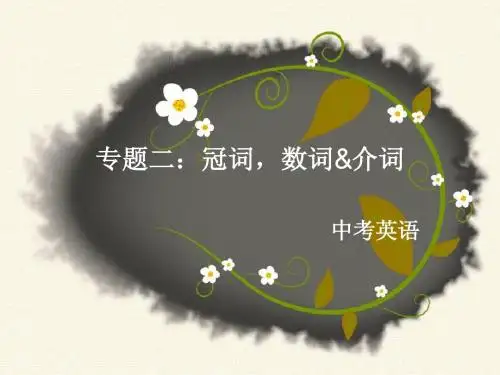
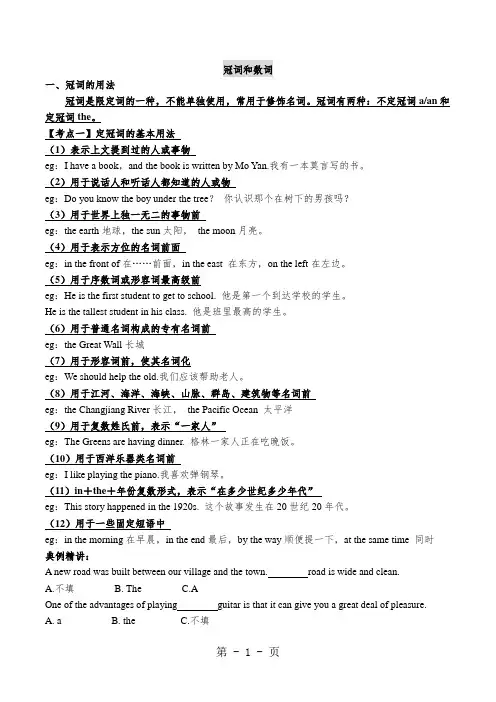
冠词和数词一、冠词的用法冠词是限定词的一种,不能单独使用,常用于修饰名词。
冠词有两种:不定冠词a/an和定冠词the。
【考点一】定冠词的基本用法(1)表示上文提到过的人或事物eg:I have a book,and the book is written by Mo Yan.我有一本莫言写的书。
(2)用于说话人和听话人都知道的人或物eg:Do you know the boy under the tree?你认识那个在树下的男孩吗?(3)用于世界上独一无二的事物前eg:the earth地球,the sun太阳,the moon月亮。
(4)用于表示方位的名词前面eg:in the front of在……前面,in the east 在东方,on the left在左边。
(5)用于序数词或形容词最高级前eg:He is the first student to get to school. 他是第一个到达学校的学生。
He is the tallest student in his class. 他是班里最高的学生。
(6)用于普通名词构成的专有名词前eg:the Great Wall长城(7)用于形容词前,使其名词化eg:We should help the old.我们应该帮助老人。
(8)用于江河、海洋、海峡、山脉、群岛、建筑物等名词前eg:the Changjiang River长江,the Pacific Ocean 太平洋(9)用于复数姓氏前,表示“一家人”eg:The Greens are having dinner. 格林一家人正在吃晚饭。
(10)用于西洋乐器类名词前eg:I like playing the piano.我喜欢弹钢琴。
(11)in+the+年份复数形式,表示“在多少世纪多少年代”eg:This story happened in the 1920s. 这个故事发生在20世纪20年代。
中考总复习讲义--冠词和数词冠词和数词教学目标、知识目标:1.连词概述;2.连词分类;3.并列连词;4.从属连词;5.考点、易错点分析;6.常用连词的用法;;7.具体语境中连词的词义和一些常用易混淆连词的区别。
二、能力目标帮助学生掌握学习词类的方法,学会举一反三。
重难点解析一、重点1.并列连词;2.从属连词;二、难点具体语境中连词的词义和一些常用易混淆连词的区别。
知识点剖析序号知识点预估时间掌握情况1 名词的分类30分钟掌握2 可数名词和不可数名词40分钟掌握3 名词所有格30分钟理解4 重点名词辨析20分钟理解教学内容:中考对冠词的考查主要为:不定冠词a和an的用法,定冠词the的用法,零冠词的用法,习惯用语中冠词的位置及使用。
一、冠词的概念及分类Grammar:冠词A.aB.anC.theD./3.(2019·丽水)Mrs. Smith has ______ 8-year-old daughter who has won two national painting prizes.A.aB.anC.theD.不填4.(2019·重庆)I have ______ English dictionary and it helps me a lot.A.aB.anC.theD./5.(2019·镇江)We can live a better life if we create ________ less polluted world.A.theB.anC.aD.不填三、定冠词(the)的用法1. 定冠词特指某(些)人或某(些)事物。
例:(1) The bag in the desk is mine. 桌子里的书包是我的。
(2) Is this the book you are looking for? 这是你要找的书吗?(3) Do you know the man in back? 你知道穿黑色衣服的人是谁吗?2. 如果第一次提到某人或事物的时候,用a / an,那么以后再次提到的话,就变成特指的人或事物了;或者说话双方都知道的名词前。
冠词和数词中考命题趋势考纲解读(冠词、数词在近5年考试中的考查点)1. 掌握不定冠词a/an和定冠词the的用法。
2. 了解不用冠词(又称零冠词)的情况。
3. 掌握基数词和序数词的构成及内部转化规律及用法。
4. 学会年、月、日、时刻的表达方式 ,了解小数及分数的表达方法。
命题预测1. 冠词、数词的考查方式以单项选择为主 ,也会在完形填空和短文填空中进行考查。
2. 据统计 ,冠词的考点有:(1)不定冠词的用法 ,如:2019咸宁 ,26题;2019·龙东 ,1题。
(2)定冠词的用法 ,如:2019·临沂 ,16题。
(3)不用冠词的情况 ,如:2019·长春 ,2题。
3. 数词的考点主要有:(1)序数词的用法 ,如:2019·绥化 ,8题。
(2) hundred ,thousand ,million与数字或of连用的具体用法。
如:2019·孝感 ,28题;2019·龙东 ,3题。
4. 预计今后中考中对冠词的考查以不定冠词和定冠词的用法为重点 ,同时也要注意不用冠词的情况和某些固定搭配;对数词的考查以序数词和hundred ,thousand ,million的用法为重点 ,同时也要注意年、月、日等的表达法。
冠词知识点全览中考考点清单考点1不定冠词(1)用于可数名词的单数形式前 ,指人或事物的某一种类。
She is a girl.(2)指某人或某物 ,但不具体说明何人或何物。
A boy is waiting for you.(3)表示“一〞这个数量 ,但数的概念没有one 强烈。
We are going to have an English lesson tomorrow.(4)用于某些固定词组中。
如:a few ,a little ,a lot of【注意】用a 还是an ,要看后面的单词的读音以辅音音素开头还是以元音音素开头。
考点2定冠词(1)特指某(些)人或某(些)物。
中考英语《冠词、数词、介词与连词》考点详解一、考查不定冠词1.用在单数名词之前,指某人或某物,但不具体说明何人或何物。
(2017年重庆A卷)There is tall man in front of the zoo gate.A. aB. anC. theD./【解析】答案A。
句意为“动物园门口前有一位高个子男人。
”表示“某一个”用不定冠词,句中tall的读音以辅音音素开头,所以使用不定冠词a。
故选A。
2.用于首次提到的人或物的单数名词之前。
(2017年呼和浩特卷)—Last Sunday, my parents took me to the zoo. In the zoo we saw elephant. elephant was from Africa.A. a; TheB. the; AnC. an; TheD. the; A【解析】答案C。
该题句意为“上星期天,我父母带我去动物园。
在动物园里我们看见一头象。
这头象来自非洲。
”第一次提到elephant,并且该词读音以元音音素开头,用不冠词an,后一空表示特指。
故选C。
3.a与an的区别:(2017年潍坊卷)—What do you think of the boy?—He is honest student today and useful man tomorrow.A. a; anB. an; aC. an; anD. a; a【解析】答案B。
该题句意为“你认为这个男孩怎么样?”“今天他是一个诚实的学生,明天就是一个有用的人。
”a与an的区别是:a用在以辅音音素开头的词前面,an用在以元音音素开头的词前面。
这里所说的是音素,而不是字母。
honest尽管拼写形式以辅音字母开头,而发音却是/'?nist /,而useful其拼写形式虽然以元音字母开头,而发音却是/'ju:sful/。
故选B。
注意以下名词前不定冠词的用法:a universify“一所大学”;a European country“一个欧洲国家”;a one-eyed dog“一只眼睛的狗”;an hour“一小时”。
教学内容:不定冠词a和an的用法,定冠词the的用法,零冠词的用法,习惯用语中冠词的位置及使用。
【一】冠词的概念及分类冠词是放在名词前面的一种虚词,没有词义,没有数和格的变化,不能单独使用,只能帮助名词或起名词作用的其他词类说明其意义。
冠词有两种:a /an叫不定冠词,the叫定冠词。
【二】不定冠词(a/an)的用法:1. a 用在读音为辅音开头的名词之前,an 用在读音为元音开头的名词之前。
【注意】(1) 这里指的是〝读音〞,而不是指字母。
例:a university / useful book / usual thing / European countryan hour/honest boy/honor(光荣;荣幸)(2) 另外在单独一个字母前也用an,如:A / E / F / H / I / L / M / N / O / R / S / X例:There is an 〝m〞in the word---music.2. 表示某一类人或某事物中的任何一个,通常在首次提到某人或某物时用a / an,以表示与其他事物的区别。
例;(1) I gave him a book yesterday. 我昨天给了他一本书。
(2) I am reading an interesting story. 我在读一本有趣的故事书。
(3) I have got a ticket. 我有一张票。
3. 用在事物的度量单位前,如时间、速度、价格等, 表示"每一个"。
例:(1) We often go to school two times a day. 我们常常一天两次去学校。
(2) I went to the library once a week at least. 我一星期至少去一次图书馆。
(3) The potato is sold at about 30 fen a jin. 土豆卖三毛钱一斤。
用于某些特定的词组。
例:a few, a little, have a good time, have a look, a number of, have a headache, have a rest, go for a walk等等5. a /an+序数词表示〝又一,再一〞。
例:I have three books. I want to buy a fourth one.可视为一个整体的两个名词前例:a knife and fork 一副刀叉典例精讲:1.(2019·来宾)—Would you like____ new blue T-shirt,Mary?—Sorry,Mom. I prefer ______ orange one.A.a;aB.a;anC.an;aD.an;an2.(2019·曲靖)—Have you seen the film Dad,Where Are We Going?—Yes.It’s ________ interesting one.A.aB.anC.theD./3.(2019·丽水)Mrs. Smith has ______ 8-year-old daughter who has w on two national painting prizes.A.aB.anC.theD.不填4.(2019·重庆)I have ______ English dictionary and it helps me a lot.A.aB.anC.theD./5.(2019·镇江)We can live a better life if we create ________ less p olluted world.A.theB.anC.aD.不填【三】定冠词(the)的用法1. 定冠词特指某(些)人或某(些)事物。
例:(1) The bag in the desk is mine. 桌子里的书包是我的。
(2) Is this the book you are looking for? 这是你要找的书吗?(3) Do you know the man in back? 你知道穿黑色衣服的人是谁吗?2. 如果第一次提到某人或事物的时候,用a / an,那么以后再次提到的话,就变成特指的人或事物了;或者说话双方都知道的名词前。
例:(1)I bought a book from Xinhua book-shop. The book costs 15 y uan.(2)I saw a film yesterday. The film was ended at eight o'clock.(3) Open the door, please.定冠词用于表示世界上独一无二的事物或用于自然界现象或方位名词之前。
这些事物当然是特指的事物,不可能有两个以上。
例:the sun the moon the earth the sky the world the spring of 2019(1) The sun is bigger than the moon. 太阳比月亮大。
(2) I can see a bird in the sky. 我能看到天空中有一只小鸟。
(3) I like to have a walk with the bright moon light in the evening.4. 定冠词与形容词连用, 可表示某一类人或事物。
〔the +形容词表示〝一类人〞)例:(1) The wounded were brought to the hospital. 受伤者被送到了医院。
(2) He always helps the poor. 他经常帮助穷人。
(3) The deaf can go to this special school. 耳聋者可以进这所特殊学校上学。
【注意】:the 用在姓名复数之前, 表示一家人。
(1) The Greens are very kind to us. 格林一家人待我们很好。
(2) The Whites like the classic music. 怀特一家喜欢古典音乐。
5. 用在形容词或副词的最高级和序数词前例:(1) He is the tallest students in my class.(2) Jim was the first student who came to school this morning.6. 用在乐器前面例:play the piano/violin7. 用在山脉、河流、海、洋、名胜古迹等由普通名词构成的专有名词前例:the Yellow River the Pacific Ocean the West Lake the G reat Wall8. 用于形容词或副词比较级等构成〝the...the... 〞的句式中,表示〝越……越……〞。
例:The more, the better.9. 用于固定搭配中。
例:all the same仍然;all the time一直;at the moment此刻;at th e same time同时;by the way顺便说;do the shopping/washing买东西/洗衣服;in the morning 在上午;in the open air 在户外,在野外典例精讲:6.(2019·永州)The little girl began to play _____ violin at the age of five.A.aB.theC.不填7.(2019·十堰)—Can you play ______ guitar?—Sure. It’s a piece of cake for me.A.aB.anC.theD./8.(2019·嘉兴)—What’s the matter with you?—I can’t remember where I parked _________ car.A.aB.anC.theD.不填9.(2019·淮安)Beijing is one of _______ biggest cities in China.A.aB.anC.theD./10.(2019·威海)Mom,I like _______ green T-shirt. Could you buy it for me?A.aB.anC.theD.不填【四】零冠词的用法:1. 人名、地名、国名等专有名词前通常不用冠词:例:(1) Mary; Tom; Jim; Miss Li; Mr. Zhang; Lei Feng(2) Beijing; Shanghai; London; Paris(3) England; China; Germany; South Africa2. 称呼语前或表示官衔,职位、身份的名词前不加冠词;例:(1) The guards took the American to General Lee.(2) Lincoln, president of the United States, was murdered in 1864.(3) In 1860, Lincoln became President of the United States.3. 当名词前有this/that等指示代词、my/your等物主代词和some/any 等词时,不用任何冠词;例:(1) This is my computer. (2) That book is their teacher’s.4. 年份、月份、星期、日期、季节、节日等名词前不用冠词:例:in 1988 in August on Thursday in spring on August 8thWe go to school from Monday to Friday.Children’s Day falls on the 1st June.5. 〝一日三餐〞等名词前不用冠词:have breakfast (lunch, supper)I have breakfast at 7 every day.【注意】(1) 前面有形容词修饰,需用不定冠词;例:He had a big dinner today. 他今天吃了顿丰盛的晚餐。
(2) 后面有定语修饰,需用定冠词:例:The breakfast he had today was good. 他今天吃的早餐不错。
6. 球类运动和娱乐运动的名称前不用冠词:例:(1). play football (basketball/volleyball/tennis/ table tennis)(2). play chess(card)7. 当〝bike, car, bus, train, boat, ship, plane〞等与〝by〞连用,表示一种交通手段时,不用冠词:by bus,by train;例;(1) He goes to work by bike. 他骑车去上班。